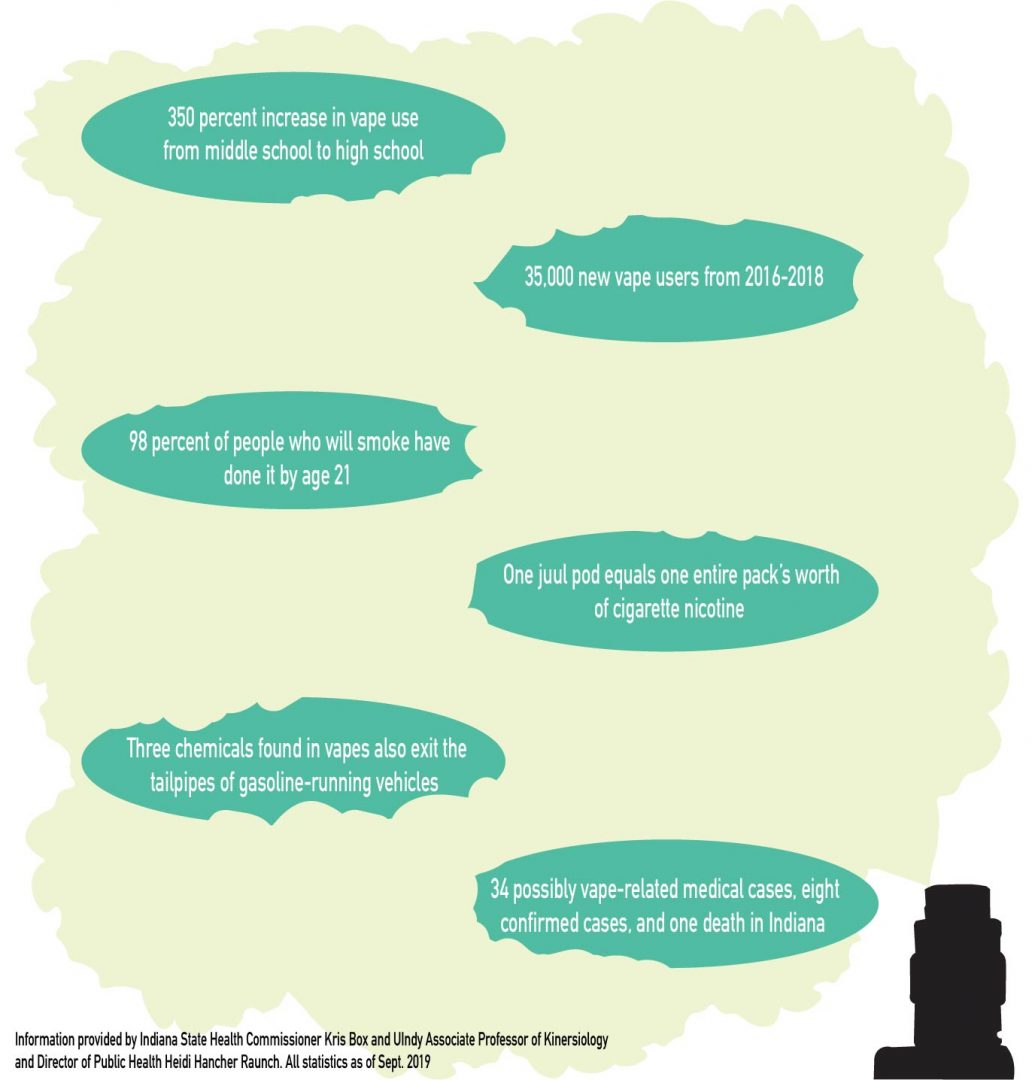The Centers for Disease Control and Prevention announced on Sept. 12 that they are investigating the recent multi-state outbreak of lung illnesses in connection with e-cigarette product use. According to the CDC, there have been 530 lung illness cases reported in 38 states and the U.S. Virgin Islands and there have been seven reported deaths from six different states where e-cigarette use is being considered a potential factor, as of The Reflector press time. One of those deaths was in Indiana, according to the CDC.
President Trump issued a statement on Sept. 11 saying that he, along with the Food and Drug Administration, intend to finalize a guidance document that would start enforcing that all flavors, other than tobacco flavor, e-cigarette products would be removed from the market.
According to Indiana State Health Commissioner Kris Box, one reported Indiana adult has died from a mysterious lung illness that was linked to vaping.
“Just one death is a horrible loss, not only to this family but to the state,” Box said. “We don’t want there to be any more deaths or any more injuries and illnesses if we can help it.”
Box said that public health officials and organizations are calling this an epidemic because of how quickly and widespread the surge in lung disease across the country has been.
“Thirty-five thousand more students in the state of Indiana took up vaping in the last two years,” Box said.
University of Indianapolis Associate Professor of Kinesiology and Director of the Public Health Program Heidi Hancher-Rauch said the public health field is currently behind in understanding what the health impact is, and now there are young adults on college campuses who have taken up e-cigarette products.
“I think we’re starting to see what that impact is on the lungs, and it’s not good,” Rauch said. “We’re seeing these young, otherwise healthy kids show up in hospitals with [a] serious lung disease, and it doesn’t respond to typical antibiotics. I mean, these people are people who felt like they were healthy a week ago and are now on a respirator. So it’s terrifying.”
According to Rauch, the recommendation for people who are trying to quit tobacco is to use FDA approved products and practices such as nicotine patches, counseling, nicotine gum and other stress management techniques. Rauch said that vaping and e-cigarette products are not yet a safe alternative.
In a statement, the Indiana State Department of Health outlined a plan to introduce various mediums for Indiana schools to use to help educate students and parents about the dangers of e-cigarette products. The plan includes an educational toolkit and a text line for youth who want to quit. ISDH also is running a public awareness campaign for the entire state to push e-cigarette cessation.
“We have really done an amazing job–not just in Indiana, but across the United States–[with] getting youth cigarette smoking down to where we have seven to eight percent of kids in high school that were smoking,” Box said. “It can be so critical that we’re reaching this age group in their education.”
Box said that part of the public awareness campaign is geared toward reaching young people on social media. According to Box, ISDH’s Tobacco Prevention and Cessation Commission hopes to come to high school and college campuses to speak with and train students and staff about how to educate more young people about e-cigarette use.
According to Rauch, there is more interest in the health effects of e-cigarette products now that these cases are making national headlines.
“They [healthcare providers] didn’t know what questions to ask,” Rauch said. “So now, as the message is getting out there to health care providers…they’re starting to ask these questions. So then we’re better able to collect that data and determine if it is vaping related or not.”
It is still unknown exactly what it is that is making people so sick, according to Rauch, so there’s really no safe way to vape right now, based on the data that public health experts have so far.
Most e-cigarette products contain approximately 29 chemicals, including nicotine, Box said, and three of those chemicals are also present in car exhaust.
“When you start to look at that, and you start to give people those facts and they’re like, ‘I don’t know if I don’t want to take that into my lungs,’” Box said. “But once you’ve already started, many people feel they can’t stop…[and that is] because of the nicotine.”
Box said that through partnering with the Indiana Department of Education, ISDH is able to start connecting more effectively with young people and make them aware of what resources are available for anyone who already has been using these products.
According to Rauch, UIndy is equipped with counselors who are available to talk to students who have questions or want to quit using addictive substances such as nicotine.
“The same place that people go for a sore throat is where you can go to talk to somebody,” Rauch said. “[You can] talk about stress management, whatever it is that can help you get over that dependence on that substance.”






